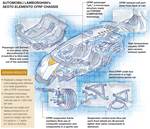Lambo goes retro with hybridized, carbon fiber-intensive LPI 800-4 supercar
The Italian specialist brings back the Countach in a limited-series vehicle featuring composite components such as a carbon fiber monocoque, exterior panels and brakes.

The Countach LPI 800-4 is a heritage model that gives a nod to its predecessors from 30+ years ago. It is also has a carbon fiber skin and structure. Photo Credit: Lamborghini
Ask any automotive designer about classic vehicle designs and you’re likely to hear “Lamborghini Countach,” a vehicle that rolled out of Sant’Agata Bolognese, Italy in 1974 and had iterations until 1990.
As the Italian builder of supersport cars transitions to an electric future, it is paying tribute to the Countach with the LPI 800-4, which has a hybridized 6.5-liter V12 with a system output of 802 horsepower (769 horsepower from the engine and 33.5 horsepower from the supercapacitor-driven e-motor).
And to make the four-wheel-drive car light (dry weight: 3,516 pounds) for high performance (0 to 62 miles per hour in 2.8 seconds), the engineers went carbon fiber intensive.
The LPI 800-4 features a carbon fiber monocoque with aluminum front and rear frames. All of the exterior body panels — hood, doors, quarter panels, etc. — are carbon fiber, with the exception of the roof, which is a photochromatic material that changes from solid to transparent with a pushbutton.
The front splitter, wind surrounds, side mirror caps, engine cover air intakes, rocker panels and rear splitter are also carbon fiber. Even the brakes are carbon fiber ceramic discs with aluminum calipers.
When the original Countach was developed, the internal project designation was LP 112. Lamborghini is building 112 of the LPI 800-4.
Related Content
-
Otto Aviation launches Phantom 3500 business jet with all-composite airframe from Leonardo
Promising 60% less fuel burn and 90% less emissions using SAF, the super-laminar flow design with windowless fuselage will be built using RTM in Florida facility with certification slated for 2030.
-
MFFD longitudinal seams welded, world's largest CFRTP fuselage successfully completed
Fraunhofer IFAM and partners have completed left and right welds connecting the upper and lower fuselage halves and sent the 8×4-meter full-scale section to ZAL for integration with a cabin crown module and testing.
-
Cutting 100 pounds, certification time for the X-59 nose cone
Swift Engineering used HyperX software to remove 100 pounds from 38-foot graphite/epoxy cored nose cone for X-59 supersonic aircraft.

.jpg;width=70;height=70;mode=crop)














